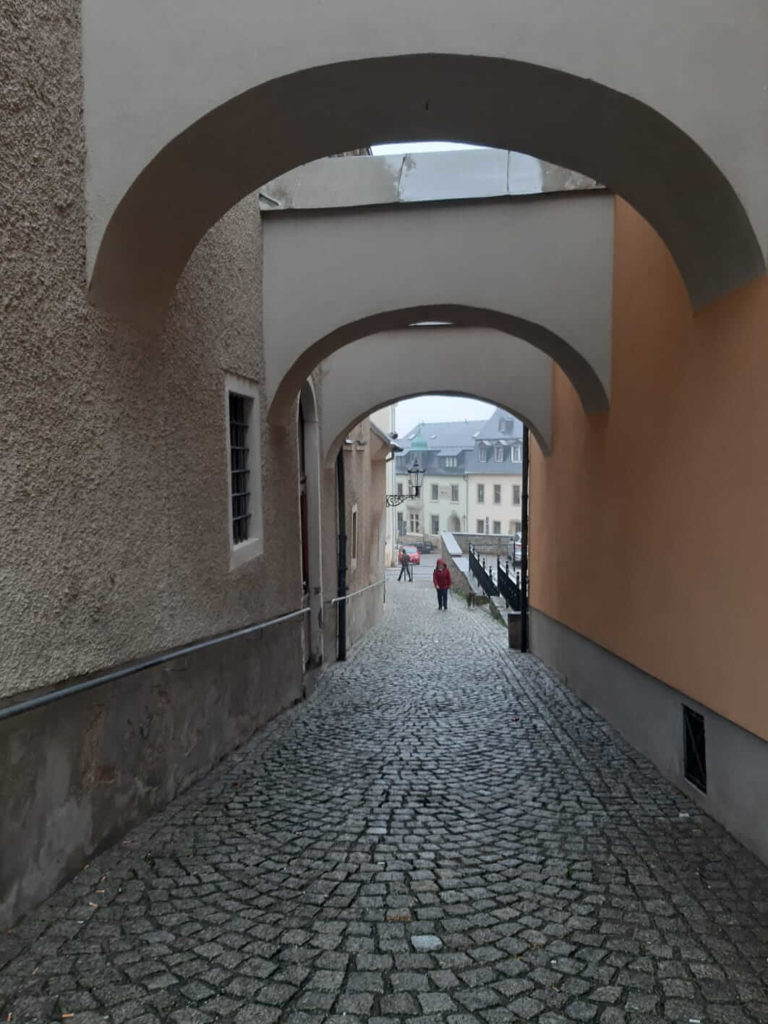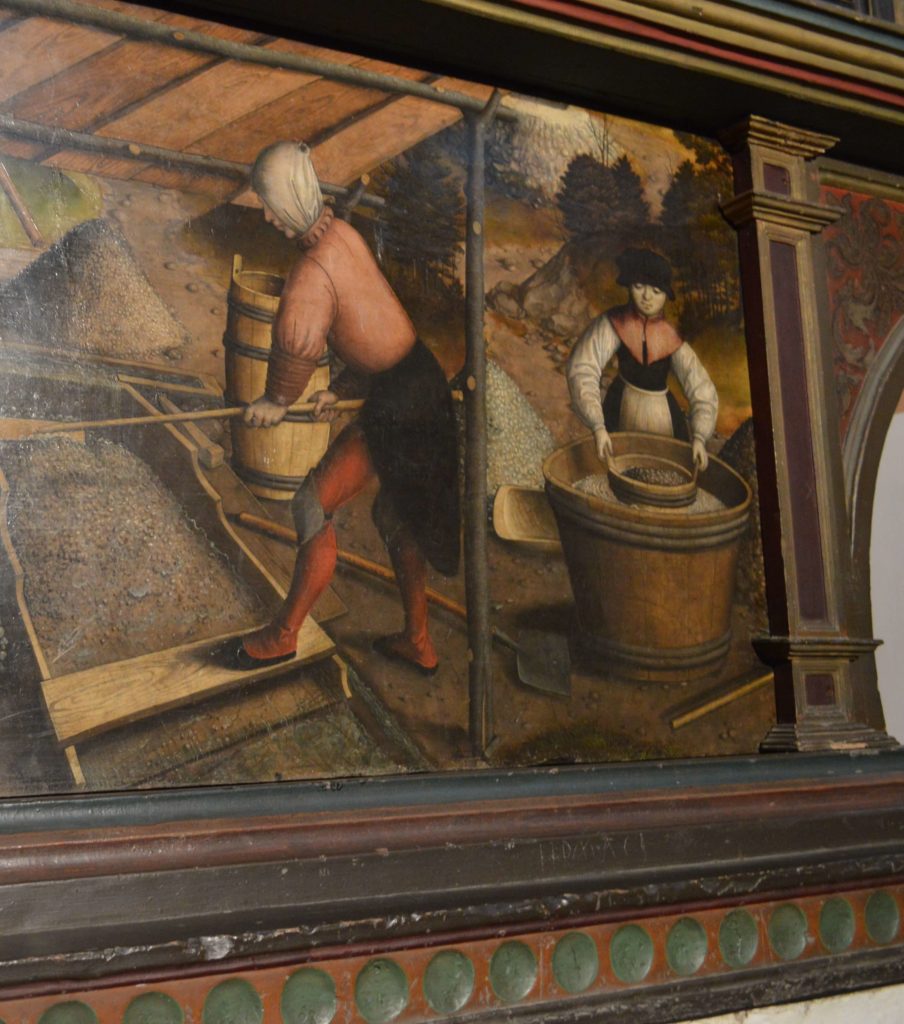by Wanda Marcussen, a student from Norway, studying International Relations and History;
Iren Bagdasarian, a student from Armenia, studying Political, Social and Economical Sciences in Italy;
and Lianne Oonwalla, a graduate of heritage studies, from India living in Germany
All that glitters isn’t gold…it could be silver, copper, tin, zinc or any other metals found in the Erzgebirge (Ore Mountains). Nestled in these mountains is the historic mining town of Annaberg. The sloping streets and misty corners paint a medieval picture of miners on their way to work, of children running in the streets. For centuries mining was a male-dominated industry; but what about the women of the Ore Mountains? What was their legacy and how did they contribute to society?

The Free State of Saxony has a past steeped in mining history, represented in modern society by its citizens. Earlier this year, the German and Czech sites of the Mining Cultural Landscape Erzgebirge/Krušnohoří were inscribed on UNESCO’s World Heritage list. This milestone attracted both international attention and local pride; banners fly in all corners of the Saxon mining towns, proclaiming “Wir sind Welterbe!” (We are World Heritage). Mining has stimulated economic and cultural growth in the state since 1168, when the first silver was found near what is now Freiberg. In this celebrated heritage, women seem almost invisible at first sight, their contributions to both cultural and economic development are not as widely discussed as their male counterparts. The town of Annaberg is a good place for an introduction to the women of the mines, and digging deeper we fit together an interesting history.
A Picture Speaks a Thousand Words
The climb uphill through Annaberg is refreshing, with a lovely reward at the top – the alluring Church of St. Annen, dedicated to St. Anne, the patron saint of mining. The foundation stone for the Church was laid in 1499 under the governance of the first parish priest to serve the town, and its long Late Gothic halls are home to many artistic treasures of both religious and historic importance. Walking across the threshold our eyes immediately fall on the three altars under the church arch. Here we get our first glimpse of the women of the mines. To the left lies the Miner’s Altar, famous for a painting on its rear by artist Hans Hesse. Illustrating the daily life of the region, the painting shows men doing hard labour, separating ore and extracting minerals, transporting heavy carriages and building houses. However, there is only one woman depicted in the altar painting, standing in front of a wooden barrel cleaning ore.

Miner’s Altar (front); Church of St. Annen/Photo Credit: Lianne Oonwalla 
A woman cleaning ore (right); Miner’s Altar (rear)/Photo Credit: Alexandra Sorina Neacșu
It was considered “irrational” to allow women work on mining sites because this kind of labour often resulted in multiple injuries or even death, therefore women stayed at home looking after the children. One could argue that women drew the longer straw in this situation because working in the mines was uncomfortable and dangerous. However, by not being allowed to participate, the women were excluded from the economic security that this work provided.
Another element of the church stands out as you make your way around the altars; the balustrades on either side of the arch display iconography that could be considered stereotypical of gender norms. The ten phases of life from birth to death are represented through the ages of men and women. Depicted with corresponding animal allegories, they clearly define the gender roles expected in the society of that time. Men look noble and courageous, their images tend to be more diverse whereas the females appear more con-generic and indiscreet. The ages of the women are whimsically compared to birds and are defined through relationships to the man, home or children, whereas the men’s ages are linked to rising ranks, bravery and wealth, represented as proud animals.

The Business that Boomed
Not all the women of the Ore Mountains kept quiet in a society where their voices were minimized to that of “housewives”. One woman took matters into her own hands. Barbara Uthmann (1514 – 1575) was the wife of a rich businessman in Annaberg, who left her ownership over several mines after his death. She continued the business of her late husband but is most famous for establishing the bobbin lace making industry in the region. She founded a school to teach young girls and women to make lace, and is believed to have employed around 900 women during her time. A true entrepreneur, she provided steady income for women in the region, which was crucial for them in order to provide for their families, and also for the economic development of the town. Uthmann met resistance from authorities and other powerful businessmen who were uncomfortable with a woman taking this role in society, but her legacy is deeply intertwined with the region’s heritage. Interestingly, St. Anne is also the patron saint of lace making, linking her protection and blessing of the region to both the male and female domains.
The Ore Mountain lace-making culture is still a very important part of the region’s heritage, and classes are offered to children and adults interested in learning the craft. In the village of Frohnau you can simultaneously explore the mining and lace making heritage. Here, an 18th century manor house once inhabited by the owners of the Frohnauer Hammer, a hammer mill across the street, has been converted into a museum. Tours are available and guides demonstrate traditional lace making techniques passed down through almost 500 years. The ensemble interestingly highlights the divided domains of men and women; on one side of the street is a museum dedicated to women’s lace making and on the other side you can visit the beautifully preserved mill where men smelted extracted metals in the old days.

Times Are a-Changin’
An exploration of Annaberg clearly reveals the position held by women in old mining societies. Bound to temporary “above-ground” jobs, they worked equally hard, polishing stones, counting freshly minted coins, or in the case of entrepreneurs like Barbara Uthmann, quietly contributing to the town’s economic and cultural growth. However, the output of the mines slowly declined in the 1600’s and the mining society became an even more exclusive “elite brotherhood” of miners. Women were pushed towards “safer” jobs like tanning and textiles. Despite the gradual exclusion from mining jobs, women like Barbara Uthmann created their own paths, improving the situation for themselves and the women that came after them.
Eventually, after a prosperous history the mines closed down permanently in 1968; most of them are now used mainly for research purposes. In 2008, approximately 800 years after the first mines were opened in the region, the German government finally passed a law allowing women to enter the mines for work, study and research. 11 years later the first woman was deployed into the mines by Bergakademie Freiberg, one of the big changes in the mining history of Saxony. Looking forward, let’s hope that this move inspires women all over the world to dig deeper, mine for inspiration, and create their own history.